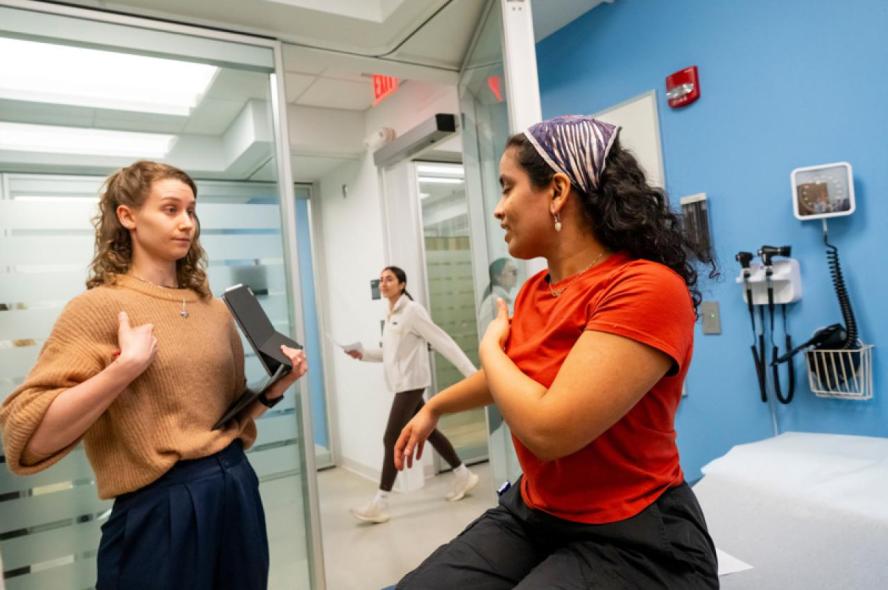-
About
- Departments & Offices
-
Academics
- Public Health
- Biomedical Sciences
- Physician Assistant
- Special Master’s (MBS)
-
Admissions & Financial Aid
- Tuition & Fees
-
Student Experience
-
- Student Resources by Program
- Academic & Student Support
- Wellness & Wellbeing
- Student Life
- Events & Traditions
-
-
Research
- Research Labs & Centers
- Tufts University-Tufts Medicine Research Enterprise
-
Local & Global Engagement
- Global Health Programs
- Community Engagement
A Day in the Life at Tufts University School of Medicine
In this photo essay, students in the MD program gave us an inside look at what a typical day might entail.

From testing fellow students' reflexes to working directly with patients in clinical rotations, students in the Tufts University School of Medicine Doctor of Medicine program (M.D.) spend their time on the Boston Health Sciences Campus putting their coursework into action.
Tufts University Chief of Photography Alonso Nichols spent the day with students to showcase what their day might look like. From first-year students in simulation classrooms to fourth-years in clinical rotations at hospitals, Nichols' photography offers a unique, first-hand perspective of the medical school experience.
Practical Skill Building
Students in the Camilla Bessey Thompson and Paul D. Thompson, M.D., Clinical Skills and Simulation Center (CSSC) build expertise and practical skills through realistic exam room exercises, interactions with standardized patients, and other immersive training experiences.
In one of the photos above, first-year M.D. students Asha Bulusu, M28, and Molee Desai, M28, practice assessing range of motion, part of a basic physical exam, during a study session.
Students in their first year spend a semester learning how to interview patients to better understand patient needs, followed by a semester building expertise in physical diagnoses by working in the CSSC with faculty and other students.
That same year, students also begin a course called Perspectives in Medicine–Patients, Populations, and Systems, directed by Sarah Rosenberg-Scott, M06, MPH06, an assistant professor at the School of Medicine, which spans the first three years of medical school. The course aims to engage how students fundamentally approach medicine and educate them on factors impacting care beyond biology of health and disease.
Clinical Rotations
Astia Innis, M25, (featured above) worked one-on-one with clinical associate professor of neurology and Tufts Medical Center neurologist Mithila Vullaganti during her rotation in neurology this year. Pictured, Innis and Vullaganti review a diagram Vullaganti has drawn to help explain a treatment plan for a patient. Innis matched into residency in the orthopedic surgery program at UConn Health.
"Something I really took from this specific rotation was the neurologists' ability to perform thorough examinations," Innis reflected. "Even though I'm going into orthopedics, fine tuning my physical and neurological exam skills is something invaluable that I took from the experience."
As she looked back on her time at Tufts, Innis noted that if she could give anyone in pursuit of a medical degree advice, it would be to listen and learn before jumping in.
"Pay attention first, be present, be there," Innis said. "Help out in any way you can. That advice is something I'll take with me, for sure."
Ed Hasaba, M25, (above) recently matched in the anesthesiology residency at Lahey Hospital and Medical Center.
Before beginning his residency, he completed a series of clinical rotations—including core clerkships—in the final two years of medical school. These rotations exposed Hasaba to specialties including the cardiovascular and respiratory systems, as well as the brain, a rotation which encompasses neuroscience, an introduction to clinical psychiatry, and addiction medicine.
In the images, Hasaba reviews paperwork before beginning rounds in his addiction medicine rotation at Tufts Medical Center. He worked with addiction psychiatrist Amanda von Horn, pictured, for the three-week rotation.
The clerkships are one of the last components of medical school, which culminates with fourth-year students being matched with a residency program, and completing specialty-specific electives and internships.